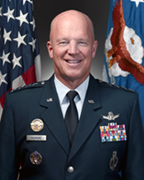
U.S. Space Command Commander General John W. “Jay” Raymond, in his first official directives, established two subordinate commands that will jointly provide support to the new Unified Combatant Command.

General
John W. “Jay” Raymond.
Combined Force Space Component Command and Joint Task Force Space Defense will focus the planning and execution of global space operations, activities and missions into two areas:
1) protection and defense from threats to U.S. space capabilities/forces
2) maintaining and growing our national security space programs, combat-relevant space capabilities, and space cadre talent to increase warfighter lethality
General Raymond said that to ensure USSPACECOM can conduct its mission decisively, he is establishing two subordinate commands with distinct and defined mission areas to ensure the command is postured to protect and defend, while also increasing joint warfighter lethality and strengthening partnerships. The establishment of the Department of Defense’s 11th COCOM dedicated to space operations reflects the value of space contributions to national security, the evolution of the threats to U.S. space systems, and the importance of deterring potential adversaries from challenging or attacking U.S. space systems. These subordinate commands will have a direct impact on that mission.
The JTF-SD will be commanded by Brigadier General Thomas L. James, with a mission to conduct space superiority operations in unified action with mission partners to deter aggression, defend space capability, and when directed, defeat adversaries throughout the continuum of conflict. The JTF-SD will execute its protect and defend mission through various operations centers, including National Space Defense Center at Schriever Air Force Base, Colorado; Space Situational Awareness Units; and Emerging Space Defense Units.
The CFSCC will be commanded by Major General Stephen Whiting with a mission to plan, integrate, conduct, and assess global space operations in order to deliver combat relevant space capabilities to Combatant Commanders, Coalition partners, the Joint Force, and the Nation. CFSCC plans and executes space operations through four distinct and geographically dispersed operations centers, including: Combined Space Operations Center at Vandenberg AFB, California; Missile Warning Center at Cheyenne Mountain Air Force Station, Colorado; Joint Overhead Persistent Infrared Center at Buckley AFB, Colorado; and Joint Navigation Warfare Center located at Kirtland AFB, New Mexico. Additionally, CFSCC executes tactical control over a number of Air Force, Army, and Navy space units.
General Raymond added that over the past decade, the great power competitors have developed technologies that threaten this nation's critical national assets in space. The U.S. has no desire to see a conflict in space and the nation is working hard to ensure no country believes they can gain a terrestrial advantage by extending a conflict to space. It’s important to understand that, like all nations, the U.S. has the inherent right of self-defense, so purposeful interference with space assets vital to U.S. national security will be met by leveraging the nation's multi-domain capabilities across air, land, sea, cyber and space, and all instruments of national power.

